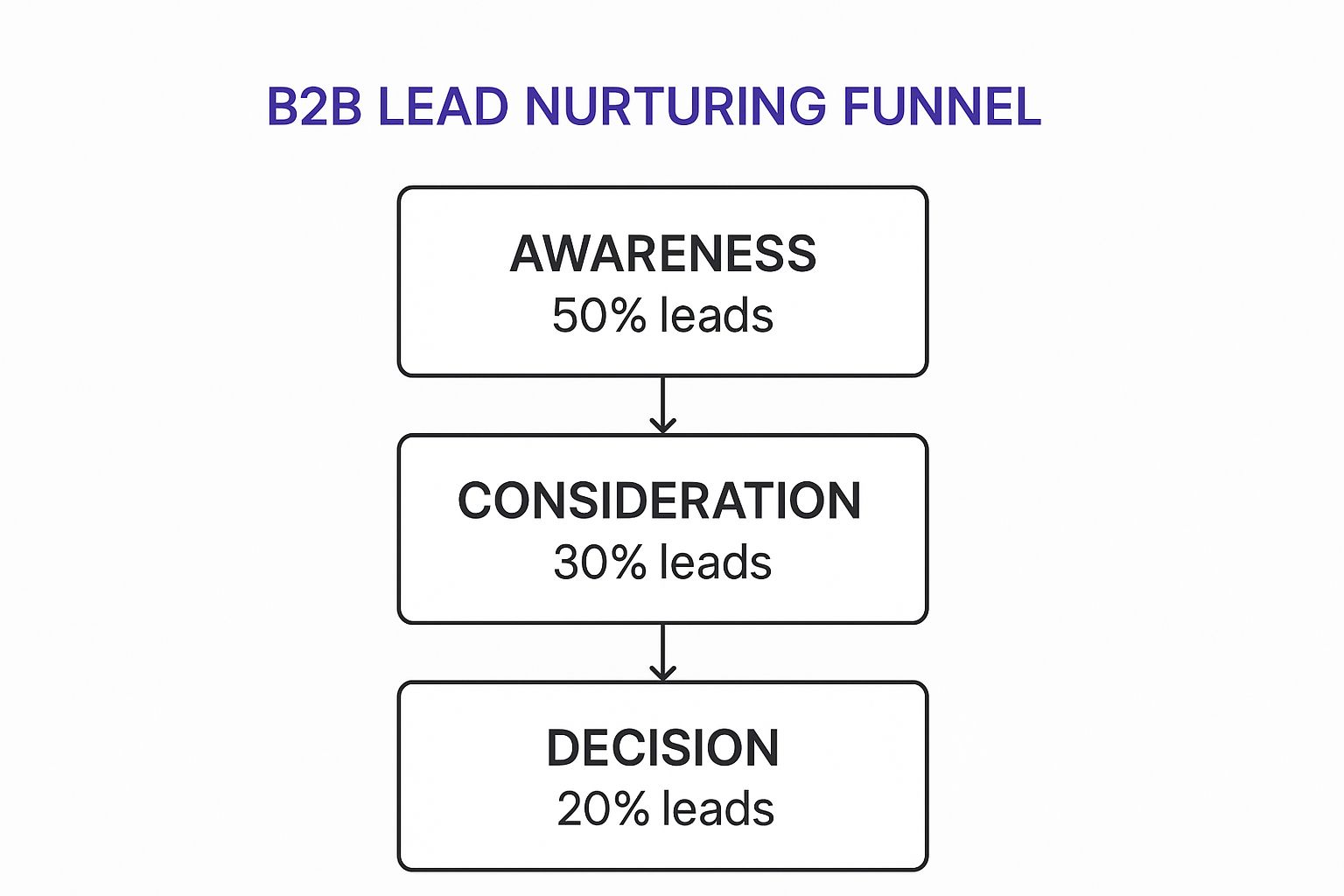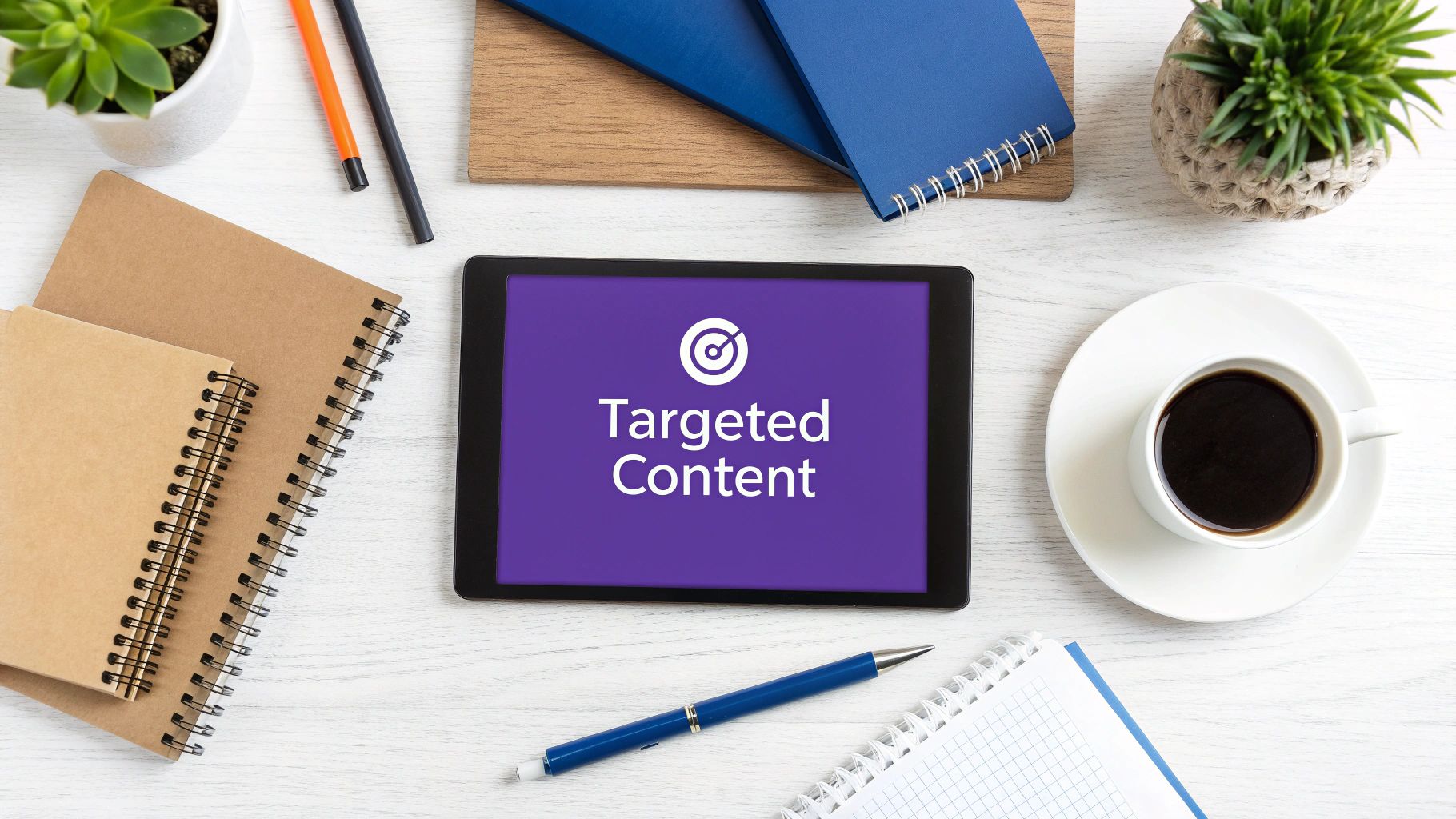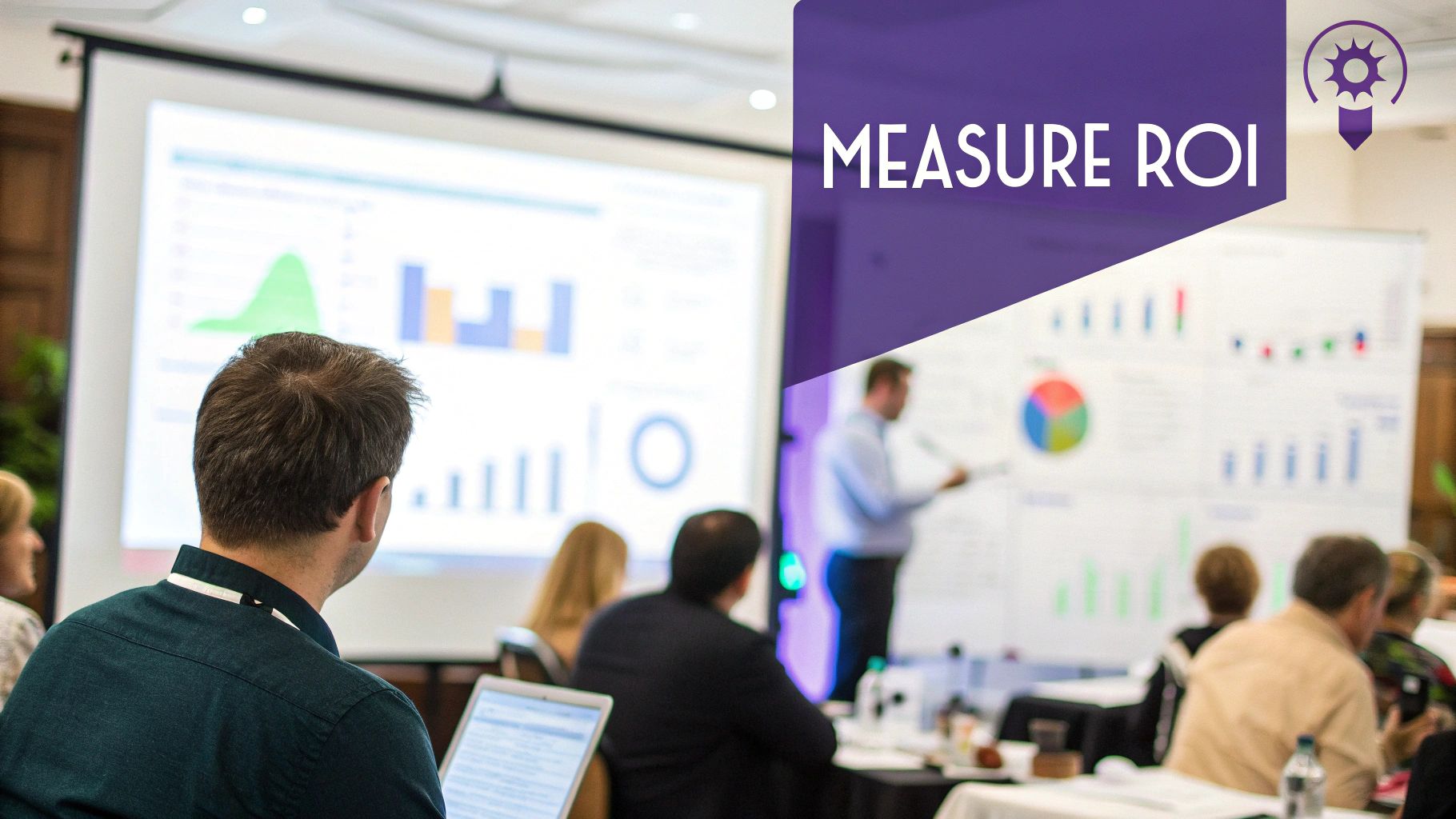So, you’ve got a list of potential B2B clients, but they’re not exactly banging down the door to buy from you. What now? This is where B2B lead nurturing comes in. It’s the art and science of building a relationship with those prospects who just aren't ready to commit yet.
The idea is to guide them along their journey, offering real value and building trust every step of the way. When they finally do connect with a salesperson, they’re not just a name on a list; they’re informed, engaged, and genuinely interested.

Think of yourself as a gardener. You wouldn't just throw some seeds in the ground, drench them with a hose, and expect a prize-winning pumpkin. It takes patience. You give them the right amount of sun, water, and care at just the right moments, helping them grow strong. That’s exactly what B2B lead nurturing is.
It’s an acknowledgment that most of the leads you generate won't be ready to buy on day one. Many of them are just starting to explore a problem or look at their options. If you toss these early-stage leads straight to your sales team, you’re setting everyone up for frustration and missed opportunities.
Nurturing is what fills that critical gap. It’s a deliberate, thoughtful process of engaging with potential customers over time—educating them, answering their questions before they even ask, and building a solid foundation of trust. For a deeper dive into these fundamentals, check out a complete guide to lead generation and nurturing.
Let's be clear: effective lead nurturing isn't about blasting out a generic email series. It's a much smarter strategy that puts the buyer’s needs front and center. The goal is to take someone who is passively curious and turn them into an active, sales-ready lead.
You do this by delivering content and resources that directly address their pain points at each specific stage of their decision-making process. A well-executed nurturing strategy means that by the time a lead talks to sales, they aren't a cold contact. They’re an informed potential partner who already sees you as a credible expert.
The core philosophy of lead nurturing is simple: stop selling and start helping. By prioritizing the buyer's educational needs, you build the trust required to earn their business when the time is right.
This shift from a hard-sell approach to being a helpful guide is what makes all the difference. You're establishing your brand as a reliable resource long before a purchase is even on the table. This patient, value-first approach pays off in several key ways:
Let's get one thing straight about B2B lead nurturing: not all leads are ready to buy. Far from it. They show up with different levels of awareness, urgency, and understanding of their own problems. Pushing a demo on someone who just realized they have a problem is like proposing on a first date—it’s just too much, too soon.
The B2B buyer's journey is your roadmap. Think of it less as a marketing funnel and more as a reflection of your prospect's state of mind. When you align your nurturing with their mental journey, you stop broadcasting at them and start having a real, helpful conversation.
This is what that distribution typically looks like.

As you can see, a huge chunk of your leads—around 50%—are just getting started in the Awareness stage. This visual makes it crystal clear why a one-size-fits-all strategy is doomed to fail. You have to meet people where they are and guide them to the next step.
At the very beginning, your lead is on a quest for answers. They’ve run into a challenge or sniffed out an opportunity, but they can't quite put a name to it yet. Their mindset is all about education.
Imagine a COO noticing that team productivity has taken a nosedive. They aren't Googling "project management software" just yet. Their searches are much broader, something like "how to improve team efficiency" or "common causes of missed deadlines."
Your job here is to be the helpful expert, not the pushy salesperson. The content you share needs to educate and inform, completely free of a heavy sales pitch.
In the Awareness stage, your goal is to help the prospect diagnose their problem. You're building trust by offering valuable insights long before they ever consider buying a solution.
This is your chance to become their go-to resource by delivering content that helps them frame their problem and understand the landscape of potential solutions.
Once a lead can clearly define their problem, they move into the Consideration stage. Now things get more focused. They’re actively comparing different approaches, methods, and categories of solutions to fix their specific pain point.
Our COO, for instance, now understands the core issue is a lack of centralized workflow management. Their questions get more specific: "best project management tools for mid-sized companies" or "collaboration software vs. task management apps." They're deep in evaluation mode, weighing the pros and cons.
This is where your B2B lead nurturing needs to get more detailed. You have to guide them through this evaluation, helping them see what a good solution looks like for their unique situation. The right content here includes things like:
The message shifts from diagnosing the problem to showing the path to a solution, positioning your category of product as the smartest choice.
Finally, we've reached the Decision stage. The lead has settled on a solution category and is now zeroing in on specific vendors to find the perfect fit. Their research is laser-focused on features, pricing, and who they can trust.
Our COO has decided they need a specific type of collaboration software. They're now asking direct questions like, "What is the implementation process for X software?" or "Can I see a case study from a company in my industry?" They're looking for proof you can actually deliver on your promises.
Your nurturing content has to provide that validation. It’s time to build confidence and erase any lingering doubts. Focus on your product and its results with case studies, customer testimonials, live demos, and free trial offers. The goal is simple: make choosing you feel like the most logical, safe, and compelling decision they can make.
To make this truly effective, you need a plan. The table below provides a clear framework for delivering the right content to leads based on where they are in their journey. It connects their goals with the most impactful content formats and messaging.
By systematically mapping your content this way, you ensure every interaction is relevant and moves the lead forward. It’s the difference between a random, disjointed experience and a smooth, guided path to becoming a customer.

Before you sink time, money, and people into a new strategy, you need to answer one critical question: what’s in it for us? While building relationships sounds nice, a real B2B lead nurturing program delivers hard, measurable results that show up on the bottom line. It’s how you turn marketing from a line item on a budget into a predictable revenue machine.
The real magic is in the efficiency. Think about it: without nurturing, your sales team is likely chasing down leads who are just kicking the tires. That’s a recipe for burnout and missed quotas. A smart nurturing process acts like an intelligent filter, warming up potential customers and only handing over the ones who are actually ready to talk business.
This methodical approach of guiding prospects with genuinely helpful content means that by the time a lead gets to sales, they're not just informed—they already trust you. That foundation is exactly what leads to higher conversion rates and a much shorter sales cycle.
The most persuasive reason to get serious about lead nurturing is its direct link to revenue. Companies that really nail this process generate 50% more sales-ready leads and do it at a 33% lower cost. This isn't just about volume; it's about attracting better, more profitable customers who are ready to sign.
But it gets even better. Nurtured leads don't just close more often—they spend more. When you build that relationship over time, you establish value and trust, which makes prospects more confident about the investment they’re making. In fact, nurtured leads spend 47% more than those who weren't guided through the process. That's a massive jump in deal size, and with email click-through rates sitting around 8%, it’s clear proof that consistent, valuable engagement pays off. You can find more compelling data in these lead generation statistics on Cleverly.co.
Investing in lead nurturing isn't just about staying in touch; it's a direct investment in larger contracts, higher close rates, and a healthier sales pipeline. It systematically increases the value of every lead you generate.
This financial upside is the number one reason companies build out a mature nurturing strategy. You stop focusing on the quick win and start playing the long game, creating a far more sustainable path to growth.
The age-old friction between sales and marketing is a notorious profit killer. Marketing sends over a pile of leads, sales complains they’re junk, and promising deals wither on the vine. B2B lead nurturing is the bridge that finally gets these two teams speaking the same language.
By creating a clear lead scoring system and agreeing on what makes a lead "sales-ready" (often called a Sales Qualified Lead, or SQL), marketing can finally deliver exactly what sales needs to succeed. This alignment creates a smooth handoff and gets everyone pulling in the same direction.
Here’s how nurturing builds that essential alignment:
This teamwork puts an end to the blame game and builds a true partnership focused on one thing: revenue. When a sales rep knows that every lead in their queue has been properly vetted and educated, their confidence, productivity, and performance go through the roof. Lead nurturing creates an operational rhythm that makes the entire company stronger.
A great B2B lead nurturing program isn’t about buying the most expensive software—it’s about having the right strategy. The ultimate goal is, of course, to guide prospects toward a sale, but how you get there matters. It’s all about providing genuine value. This is where your tactics need to be thoughtful, turning a simple email sequence into a powerful engine for building real relationships and driving revenue.
The whole game hinges on relevance. Generic messages get deleted instantly. But content that speaks directly to a prospect’s specific challenges and industry? That’s what builds trust. The following strategies are the bedrock of a program that feels personal, timely, and actually helpful to every lead in your pipeline.
Let's be honest: not all leads are created equal. Treating them the same is a surefire way to get ignored. Strategic lead segmentation is simply the practice of dividing your prospects into smaller groups based on what they have in common. This lets you ditch the one-size-fits-all messaging and deliver content that truly clicks.
Think of it like being a great gift-giver. You wouldn't buy the same present for your tech-obsessed best friend and your garden-loving grandma. You think about their individual interests to find something they'll actually appreciate. Segmentation does the same thing for your leads, making sure you’re offering the right information to the right person.
You can slice and dice your audience based on a few key criteria:
Once you have your segments, you can start getting personal. And no, I don't just mean dropping a {FirstName} tag into your email subject line. Real personalization makes the entire experience feel like it was designed just for them. It’s about using context.
For example, instead of sending a generic case study, you send one featuring a company in their exact industry and of a similar size. If a lead downloaded your guide on "improving team efficiency," your follow-up emails should focus on collaboration tools and productivity metrics, not your entire product suite.
True personalization is the difference between a form letter and a personal note. It shows you haven't just captured their information—you've been paying attention to their needs.
Today's B2B buyers don't just live in their email inboxes. They're scrolling through LinkedIn, asking questions in industry forums, and seeing targeted ads all over the web. A smart lead nurturing B2B strategy meets them wherever they are.
This doesn't mean you should spam them on every platform. It's about creating a smooth, coordinated experience. For instance, a lead who engages with your content on LinkedIn might later see a relevant display ad, which is then followed by a highly targeted email that picks up where the conversation left off. After that initial outreach, a huge part of the B2B buyer's journey is the follow-up. For some great templates and advice on this, check out these resources on Crafting Perfect Follow-Up Emails After Initial Consultations.
Finally, you could have the best nurturing program in the world, but it will all fall apart with a clumsy handoff between marketing and sales. Both teams need to be on the exact same page about what makes a lead "sales-ready." This is where lead scoring and crystal-clear communication are essential.
Lead scoring is just a system for assigning points to leads based on who they are and what they do. A director-level contact from a target industry gets more points than an intern. Visiting the pricing page is worth more than reading a single blog post. Once a lead hits a certain score, they're automatically flagged as a Marketing Qualified Lead (MQL) and passed over to sales.
This alignment stops sales reps from wasting time on tire-kickers and ensures they only talk to prospects who have shown real interest. It also gives them a cheat sheet on what that lead cares about, making that first conversation infinitely more relevant and productive. This is a massive stumbling block for many companies. While around 60% of B2B marketers send leads straight to sales, less than 30% of those are actually qualified. It's a broken system that highlights just how badly this alignment is needed.
A strategy without measurement is just a guess. While it’s tempting to celebrate high email open rates, those surface-level stats don’t tell you the whole story about whether your B2B lead nurturing is actually working. To prove ROI and make smart adjustments, you have to track the metrics that connect your nurturing activities directly to revenue.
Think of it like a car's dashboard. The speedometer (open rates) is useful, but it doesn't tell you if you have enough fuel (lead quality) to actually reach your destination (a closed deal). A successful program needs a full set of gauges to measure efficiency, momentum, and overall health. This means focusing on KPIs that show a real business impact.
The first step is to look past the simple engagement numbers. Don't get me wrong, metrics like click-through rates are important for figuring out if a specific email is hitting the mark, but they don't show if your overall strategy is paying off. The real goal is to see how well you’re guiding leads from "just looking" to "ready to talk."
To do that, you need to zero in on metrics that track a lead’s progress through their buying journey. These KPIs give you a clear, data-driven feedback loop, allowing you to test, analyze, and fine-tune your campaigns for the best possible results.
Here are the key metrics that reveal the true health of your nurturing program:
Let’s dig into the metrics that truly matter. Keeping an eye on these numbers will give you a complete picture of your campaign’s success and point you directly to areas that need improvement.
1. Stage-to-Stage Conversion Rates
This is your most direct measure of how effective your nurturing is. If you have tons of leads entering the Awareness stage but only a trickle are making it to Consideration, you've got a problem with your content or your timing. Low conversion rates here are a clear sign that your early-stage nurturing isn't building enough interest to keep people engaged.
A healthy stage-to-stage conversion rate is proof that your content is hitting the mark and successfully guiding prospects along their journey. It’s the clearest sign that your nurturing is actually moving the needle.
2. MQL to SQL Ratio
This is the ultimate test of sales and marketing alignment. A low MQL-to-SQL ratio—where sales rejects a high percentage of marketing’s leads—is a massive red flag. It usually means your lead scoring is too optimistic or your nurturing content isn't properly preparing leads for a real sales conversation. A strong ratio, on the other hand, shows marketing is delivering genuinely qualified and educated leads.
3. Sales Cycle Length
Time is money, right? An effective lead nurturing B2B strategy should absolutely shorten the sales cycle. By educating prospects and building trust before they even talk to a salesperson, you’re answering their questions and removing friction from the process. Tracking this for nurtured versus non-nurtured leads gives you hard evidence of your program's ROI. If nurtured leads are closing 20% faster, you’ve built a powerful business case.

As your pipeline grows, trying to manage every lead by hand feels like trying to have a meaningful chat with every single person in a sold-out stadium. It’s just not going to happen. This is exactly where technology comes in, helping you evolve your B2B lead nurturing from a manual chore into a smart, scalable system.
Automation is great for the repetitive stuff, like sending a follow-up email after someone downloads a whitepaper. But AI takes things to a completely different level. Think of AI as a brilliant assistant that sifts through mountains of data to make intelligent decisions—the kind that used to require years of marketing experience. It doesn't replace the marketer; it gives them superpowers.
With AI, you're no longer stuck with rigid "if this, then that" workflows. The technology can start predicting which leads are most likely to buy, figure out the perfect time to reach out, and even tweak your messaging on the fly based on what a prospect just did on your website.
For a long time, there was a major trade-off in marketing. You could either have deeply personal, one-on-one interactions with a handful of top accounts, or you could blast generic messages to thousands. AI completely shatters that old limitation, making it possible to deliver hyper-personalized experiences to everyone in your database.
AI-powered platforms watch how a lead interacts with your website, social media, and emails. Based on this behavior, the system can dynamically adjust the nurturing journey for each person, making sure every touchpoint feels like it was made just for them.
The real magic of AI in lead nurturing is its ability to understand and react to individual buyer intent in real time. It shifts the focus from a pre-planned sequence to a dynamic, responsive conversation.
Let's say a prospect suddenly starts binge-watching your case studies for the healthcare industry. An AI system can instantly change course, sending them more content specific to that vertical. This simple pivot keeps your communication relevant to their immediate interests, pushing the conversation forward naturally.
Traditional lead scoring works, but it's based on a fixed set of rules you create. AI introduces predictive lead scoring, a much smarter approach. It uses machine learning to comb through your historical data, identifying the subtle characteristics and behaviors of your best customers.
From there, it scores new leads based on how closely they resemble that ideal customer profile, giving you a far more accurate picture of who is actually ready for a sales call.
Tools like Upcraft take this even further. They use conversational AI to engage leads in a natural dialogue, qualifying them and even booking meetings on your sales team's calendar automatically.
This is a perfect example of how AI agents can take over the time-draining tasks of initial outreach and follow-ups. By automating these critical early-stage interactions, you ensure no lead ever falls through the cracks and every opportunity is pursued with persistence and precision. It frees up your human team to do what they do best: build relationships and close deals.
Even the best-laid plans run into questions once you start putting them into practice. Let's tackle some of the most common ones that pop up when building a B2B lead nurturing program.
There's no single right answer here—it all comes down to your sales cycle.
For a straightforward SaaS tool, a few weeks of consistent follow-up might be all it takes. But if you're selling a complex enterprise system that requires buy-in from multiple departments, you could be looking at a campaign that spans six months or more.
Your goal is to mirror your typical buyer's journey. Keep an eye on engagement. Are they opening every email? Clicking on links? That might be a signal to speed things up. But if they go quiet, give them some space. The point is building a relationship, not just blasting them with content.
This is one of the most important distinctions to understand. Getting this right is what separates basic email blasts from a truly effective nurturing strategy.
Static Drip Campaigns: Think of these as a pre-set playlist. Every lead gets the same emails in the exact same order, no matter what they do. It’s a rigid, one-size-fits-all approach.
Dynamic Lead Nurturing: This is more like a live conversation. The system reacts to what a lead does. If they visit your pricing page, it might send them a case study about ROI. If they download a whitepaper on a specific feature, it sends them more info on that topic. It’s flexible and personal.
A drip campaign is like a pre-recorded museum tour—it recites the same script for everyone. Dynamic nurturing is like having a personal guide who can answer your questions and show you the exhibits you're most interested in.
You might have heard the old marketing rule of seven touchpoints. In today's noisy world, that's often not enough.
For most complex B2B sales, expect to need anywhere from 10 to 15 meaningful touchpoints before a lead is ready to talk. And these aren't just emails. They can be social media interactions, a webinar they attended, or even a retargeting ad they saw.
The key word here is "meaningful." Each touchpoint has to add value and push the conversation forward. It’s about the quality of the interaction, not just hitting a certain number.
Ready to stop leads from going cold and start converting them with intelligent, persistent conversations? Upcraft provides AI agents that engage every lead, qualify them, and book meetings automatically, freeing your sales team to focus on closing. Discover how it works.
Enter your contact information and Archer will start a conversation with you via text message.